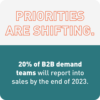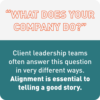Though it’s asked in different ways, lately, we’re hearing the same question from senior-level marketing clients: How can I create a lead pipeline? How can I show a link between brand awareness and revenue? How can I shore up my marketing activities ahead of budgets tightening?
It’s no secret there’s a strong tie between the state of the economy and the uptick in these requests. When budgets tighten, integrated marketers must make cuts somewhere. But if you are considering cutting top-of-funnel (TOF) spend to ensure you hit your lead generation goals, don’t. Brand feeds demand and you can show that correlation in a way that satisfies both your sales team and your Board.
First, some numbers (we like data here, after all) and some expert insight.
 Forrester expects that 20% of B2B demand teams will report into sales by the end of 2023. As B2B Marketing expert Matt Heinz explained, “This is not only short-sighted … it also indicates a failure of marketing to articulate a value to the organization beyond serving as a ‘lead machine.’”
Forrester expects that 20% of B2B demand teams will report into sales by the end of 2023. As B2B Marketing expert Matt Heinz explained, “This is not only short-sighted … it also indicates a failure of marketing to articulate a value to the organization beyond serving as a ‘lead machine.’”
Further, marketing expert John Ellett also commented on the statistic in Forbes: “This move will exacerbate the bifurcation of brand and demand programs, leading to less reputation-enhancing activities in favor of immediate lead generating programs. This will likely hurt demand programs in the long-term when the company’s relevance slowly devolves after quarters of underinvesting in brand programs.” Not to mention, turn demand into a numbers game instead of an experience story.
So, when our clients ask questions about the pending recession and their brand, our advice is similar to what you might hear from a financial advisor when it comes to stock investments: don’t panic and pull your brand investment out of the “market” now. Stay in the game and it will serve you in the long run. More specifically, while your competitors are pulling back, invest in campaigns that explain your mission, tell stories that educate, and are closely aligned with your values and the feelings your audience is experiencing in this moment.
Here’s how we ensure our clients’ brand work feeds demand generation to help them differentiate from competitors and achieve revenue goals. In other words, how you can thrive while others just survive.

If you want leads, awareness isn’t optional (more on that later), which means a strong brand story is also non-negotiable. Do the work now to get on the same page about the story you want to tell — a clear, concise story that will show your target audiences how you can make an impact. This is an important exercise because we often hear different members of client leadership teams answering the question, “What does your company do?” in very different ways.
 Our preference as creative storytellers is to kick off client engagements with a messaging and positioning exercise. This work often involves a “listening tour” in which we speak with the various internal brand and product marketing stakeholders who know customers best; a competitive audit in which we determine how you can cut through the “noise” and differentiate, while highlighting the product value propositions that will resonate most in the current buying environment; and, ultimately, a messaging framework that has your buy-in and helps ensure everyone sings from the same song sheet — whether that song is content, media interviews or website copy.
Our preference as creative storytellers is to kick off client engagements with a messaging and positioning exercise. This work often involves a “listening tour” in which we speak with the various internal brand and product marketing stakeholders who know customers best; a competitive audit in which we determine how you can cut through the “noise” and differentiate, while highlighting the product value propositions that will resonate most in the current buying environment; and, ultimately, a messaging framework that has your buy-in and helps ensure everyone sings from the same song sheet — whether that song is content, media interviews or website copy.
For one client, PAN looked across top competitors and upstream to market leaders for insight into the brand’s whitespace storytelling opportunity. The team simultaneously monitored trending topics across the web and earned media to better understand what customers and consumers cared most about. Based on this exercise, the PAN team presented a revised tagline, company elevator pitch and differentiated value propositions across its offerings. The results were immediate. Not only did the team increase the client’s share of voice in earned media by 3x, PAN also secured 23 earned media opportunities and increased overall brand mentions by 23% in 90 days.

An important part of this foundational work is also measurement — specifically collecting baseline numbers for the metrics that matter to your sales and revenue organization. We work with senior marketing and revenue leaders to determine these specific metrics for each client, but examples relevant to digital visibility include organic traffic, referral traffic, conversion traffic and branded search visibility, as well as traditional PR metrics like earned media share of voice, message pull-through and social media share of voice. Establishing a baseline early on will help you demonstrate the value of your brand visibility work down the road.
Dig deeper into data with our brand research tool, the Digital Visibility Audit (DiVA).

Back to the earlier point about awareness. When talking about demand generation, awareness and consideration campaigns must be part of the conversation. For those efforts to be successful, your digital presence has to be up to snuff. Start by making sure your website and other owned channels (e.g., social media channels) reflect the story you want to tell, that they accurately describe your offerings or products in a streamlined way (brevity is best) and — most importantly — that your website is discoverable. Websites are the living, breathing core of a business today. It’s critical to maintain the health, functionality and visibility of a website. SEO plays a big part here and is an area where PAN can and does play deep.
Of course, the website alone is only half the battle. You also must ensure you have plenty of content on the site and beyond (media and influencer relations come into play here) that demonstrates your brand expertise.

Demand Gen Report found that 87% of B2B buyers give more credibility to industry influencer content like third-party published articles, so this thought leadership aspect is vital to driving traffic to your site. And by offering insights for free, you’re making a long-term investment that can lead prospects down the funnel. For one client, the PAN team helped develop 25 pieces of creative and strategic content in one quarter that drove a more than 45% QoQ increase in unique visitors to their resources page.
It’s also important to ensure you’re providing content along your target audience’s journey from awareness to consideration. If a prospect returns to your website for more information after an initial visit, that deeper content can make all the difference in converting them. Recent PAN research found that only 56% of marketers said their content efforts were attributed to revenue.
As you refine your content marketing strategy and work to develop the right mix and depth of content assessing and auditing your content is essential.

Now that you’re telling the right story, your website is clean and updated, and you have proof of expertise, it’s time to put some money in market. Make sure you know where your audiences spend the most time (whether it’s LinkedIn, YouTube or Quora, an initial audit can reveal important insights) and start putting your thought leadership content to work. Consider a range of dynamic content — from media hits and checklists to image carousels, how-to videos and voice of customer videos — for awareness ads to help drive TOF leads. Consider deeper content — like product ads, deals and offers — for generating lower funnel leads via consideration campaigns.
 For our clients, we look to develop cohesive, integrated campaigns that include earned, owned and paid media. Start with a survey of your audience on an emerging, important topic. Once you’ve distilled the resulting data, develop a press release, blog or eBook, sharing that valuable insight with your unique brand POV to help make sense of it. Then build paid campaigns to spotlight key findings in static and animated ads to drive prospects to that content on your site, always ensuring there’s a tangible CTA awaiting them — whether it’s a checklist to help prospects do their jobs better or an offer to speak with an expert at your company.
For our clients, we look to develop cohesive, integrated campaigns that include earned, owned and paid media. Start with a survey of your audience on an emerging, important topic. Once you’ve distilled the resulting data, develop a press release, blog or eBook, sharing that valuable insight with your unique brand POV to help make sense of it. Then build paid campaigns to spotlight key findings in static and animated ads to drive prospects to that content on your site, always ensuring there’s a tangible CTA awaiting them — whether it’s a checklist to help prospects do their jobs better or an offer to speak with an expert at your company.
Remember those baseline metrics you established at the foundation? Revisit those KPIs quarterly, or at least every six months. Examining metrics like email open rate, CPL, CTR, time on page, social likes/shares/follows that are relevant to the specific brand amplification campaigns you’ve executed will also help to show progress and demonstrate the value of the foundational brand awareness investments you have made.
One PAN team recently leveraged original client research to create more than 20 content assets for use across the client’s owned and paid communications channels, including eBooks, infographics, sell sheets, visual advertisements, videos and more. In just one quarter, these assets collectively generated 634 new leads, 4.6K total engagements and 1.9K web clicks (a 95% increase from prior quarter). Email proved a particularly powerful channel for this client, with quarterly email content serving up a 50% increase in click-through rates, resulting in a 142% increase in web traffic coming from email marketing over the prior quarter.

PAN helps clients maximize their storytelling arsenals via B2B demand and lead generation campaigns. Our support runs the gamut from strategic advisors and content strategists — helping to select channels, build targeting and ensure performance — to running these campaigns wholesale as execution partners. We establish metrics specific to each campaign at the outset so we can adjust and pause as needed. Having a solid nurture strategy in place is critical as well, to maximize your investment and likelihood of closing a sale.
A smart story drives brands that matter to your funnel. When faced with headwinds, businesses can waste so much valuable time chasing bad leads. Working as a unified storytelling machine will help avoid those missteps and drive audiences to your funnel that truly belong there — and deliver the impact and outcome you need to show value during a recession.
Need help building a cohesive brand to demand strategy to support your lead gen goals? Get in touch to learn more about the successful PAN clients who are winning with strategic storytelling.



